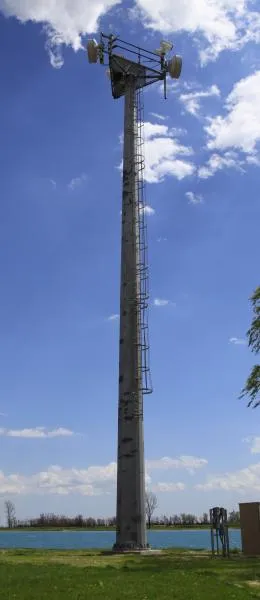
Artificial Intelligence Turns the Tide on Securing Northern Border Waterways

Security along the Canadian border from Buffalo, New York, to Detroit and north to Port Huron, Michigan — a more than 360-mile stretch entirely separated by water — has been challenging. In a region awash with numerous marinas, thousands of pleasure craft, and hideaway canals and channels that reach deep into shoreline neighborhoods, identifying and catching lawbreakers can feel overwhelming.
For years, catching smugglers, drug runners and the like trying to slip through the border hinged on estimating when and where illegal activity would be likely.
“Agents relied on local knowledge and local connections,” said Jonathan Lake, supervisory law enforcement information systems specialist in the Buffalo sector.
That’s changed.

equipment is mounted on structures, such as this pair of
day and night cameras affixed to a building overlooking
Port Huron, Michigan. Photo by Heath Stephens
Now, 22 sites of high-resolution cameras and radar driven by artificial intelligence — called the Northern Border Remote Video Surveillance System or NBRVSS — adds critical capability to Border Patrol operations. Sites are strategically placed along that waterway for maximum coverage. Some radar units and cameras are on towers, while others are mounted on buildings and structures, like the one atop the 73-story General Motors Renaissance Center in downtown Detroit.
NBRVSS is powerful. It detects and monitors vessels from miles away that leave the Canadian shoreline and warns operators when a vessel enters an alert area thanks to custom software that recognizes unusual vessel movements from ordinary traffic. That’s huge, particularly during the summer boating season when hundreds of vessels are on the water. In the past, Border Patrol boat crews could only inspect suspicious vessels they came upon. Today, they’re directed to those vessels, a dramatic shift.
“It’s like going from lights off to lights on,” said Steve Oldman, the Buffalo sector’s intelligence unit agent-in-charge.
Buffalo and Detroit sectors manage the system through their command centers. Operators have several screens at their workstations showing views from the various sites. Other screens list available equipment and personnel, and another provides a bird’s-eye radar map of vessels on the water throughout the entire region.
Vessels appear as tiny yellow squares. When an operator clicks over any square, it immediately lists the vessel’s speed and direction. If a vessel enters the alert area, the yellow square becomes a red diamond, and an audio alarm sounds. Displays can also be projected on the huge video wall in the front of the room.
“The system shows the number of boats and traffic flow at any given time,” Oldman said. “Before that, it was a guess.”

Jonathan Lake, supervisory law enforcement information systems specialist in the Buffalo sector, uses multiple monitors to quickly view and pin point the identity, location, speed and direction of vessels of interest on the lake and riverine border with Canada. Photo by John Schmelzinger
Border Patrol assets are now put to better use while safety, accuracy and situational awareness have increased. “This radar has given us a level of confidence to dispatch a Border Patrol vessel,” Lake said.

this tower is one of 22 sites making up the Northern
Border Remote Video Surveillance System network
of cameras and radar. Photo by Heath Stephens
Many times, operators can quickly zoom into a suspect vessel, giving the pursuing agents valuable information about the vessel and its crew, more than just speed, direction and location.
The camera can reveal what the craft looks like, number of people on board and obtain the boat’s registration number so agents can perform background checks. This information is then relayed to the patrol boat well before the intercept, explained Dennis Karwowski, the agent assigned to the Detroit Border Intelligence Center.
In a demonstration, a radar blip was randomly picked and matched to a camera. Instantly, the vessel appeared on the huge video wall in the front of the room, a pleasure craft speeding along. The vessel appeared from a distance. Then the operator zoomed the camera for an amazing close up. People on board could be seen as well as with the boat’s registration number on the bow.
“We can zero into a vessel beforehand,” he said. “This extra level of information increases agent safety. You know what to prepare for and it limits the time you’re in a risky position.”
In addition, patrol boat operators have a screen where the suspicious vessel’s symbol lights up and its track revealed to prevent any mistaken identity.
Still, an agent’s experience becomes even more valuable using NBRVSS. While the system shows movements, only an agent can determine if they’re suspicious.
A jet ski dashing across the waterway, two vessels rendezvousing, or a boat skirting the international border on the Canadian side of the waterway and then turning sharply at high speed toward the U.S. shore are typical tactics smugglers use when delivering their contraband, explained Agent Kamil Forys, while patrolling Lake St. Clair in a Border Patrol boat.
Agent Travis Samperi uses a laptop while onboard to match surrounding vessels with the radar blips displayed on his screen. Handling the keyboard is an effort as the patrol boat slams through the wind-whipped surf. “What you see on the wall of the command center looks a lot different out here,” Samperi said, as he gazed over the water.
Information from the system is also shared with Canadian border security officials by Border Patrol agents who work at the Marine Security Operations Centres in St. Catherines, Ontario. The centres are a multi-agency security and law enforcement operation.
To advance that partnership along with border security, the Border Patrol plans eventually to crew its patrol boats with both Border Patrol and Canadian border agents as members of the U.S. and Canadian Coast Guard do.

